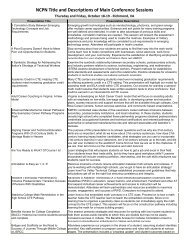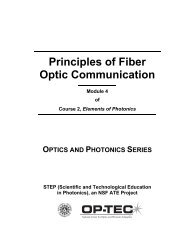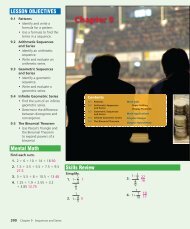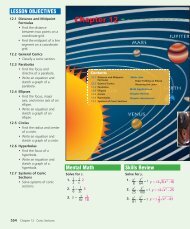Chapter 10 - NCPN
Chapter 10 - NCPN
Chapter 10 - NCPN
Create successful ePaper yourself
Turn your PDF publications into a flip-book with our unique Google optimized e-Paper software.
Activity<br />
Ambiguous Cases<br />
Two triangles that have a<br />
congruent angle and two pairs<br />
of congruent sides are not<br />
necessarily congruent as shown<br />
below. The Law of Sines can be<br />
used to find the missing angle<br />
measures for both triangles.<br />
1 Use the Law of Sines to express the relationship between<br />
∠A and ∠B. sin43<br />
° = sin B<br />
16 20<br />
2 Solve the equation from Step 1 for m∠B. Round your answer to<br />
the nearest tenth. 58.5°<br />
3 The sine function is positive in Quadrant I and II. Therefore,<br />
another value for m∠B can be found by subtracting the answer<br />
from Step 2 from 180°. Find another value for m∠B. 121.5°<br />
4 Find the other missing angle measures in the two triangles.<br />
Express the angles of the two triangles that satisfy the given<br />
conditions and the Law of Sines. Blue triangle: 43°, 58.5°, 78.5°;<br />
Orange triangle: 43°, 121.5°, 15.5°<br />
For any triangle ABC, if a, b, and c represent the side lengths opposite<br />
angles A, B, and C, respectively, then the Law of Cosines states that<br />
a 2 = b 2 + c 2 – 2bccos A,<br />
b 2 = a 2 + c 2 – 2accos B, and<br />
c 2 = a 2 + b 2 – 2abcos C.<br />
The Law of Cosines can be used to find missing measurements in triangles<br />
when the measures of two sides and the angle between them are known or<br />
when the measures of all three sides are known.<br />
<strong>10</strong>.5 The Law of Sines and Law of Cosines 465











